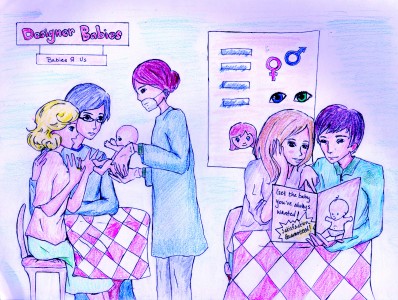Yes, I’d like one baby please. No, make that two. Red-hair, freckles, and green eyes on the side, please. Also, I’ll have the bonus package with the high IQ and great personality. Oh, and make sure to check for any potentially nasty diseases. Thanks.
This fast-food order gone awry is the possible future for parents everywhere, as DNA and genetic testing are making the dreams of a “designer baby†more and more likely. Using a procedure called pre-implantation genetic diagnosis (PGD), scientists can now accurately predict certain genetic diseases in potential embryos, ensuring that the chosen one is healthy. As of late, geneticists and fertility experts have been using PGD for more cosmetic purposes, such as gender selection. It is predicted that, once more has been discovered about DNA, traits such as height, eye color, and even IQ can be screened for and selected in potential embryos.
Most fertility clinics now offer PGD along with their in vitro services, and are able to screen for about 60 genetic diseases. The response to this has mostly been positive.
“For genetic diseases, I believe that’s a case which most people can reconcile with, although I know some people have reservations with even that,†biology teacher Craig Sucher said.
In general, the positive response to PGD, when used solely for disease-diagnosis, has been based on the high-importance the community places on making sure a child is raised in a way that offers them the best chance at a healthy and happy life.
“We expect, in our society, that parents do everything they can do, within their means, to provide for the health, the well-being, the safety of their children,†Sucher said. “Even before protection, they’re providing for the potential health and well-being of their children.â€
However, despite procedures like PGD, the use of in vitro fertilization is still hotly debated, as some feel it goes against what it means to have a child.
“Simply trying to bring about children through IVF is already ethically problematic,†SLU Assistant Professor of Health Care Ethics Jill Burkemper said. “It seems there’s something to be said about the appropriateness of sexual intimacy as the physical origins of a human being’s existence. As much as couples love each other and want to have children, ought they to allow the origin of their child to be the act of a technician working to unite their gametes?â€
Still, it has also been suggested that, with high-success procedures like PGD, couples in the future will rely almost completely on science to have children. This idea is sharply contradicted by the fact that a large number of pregnancies are not planned.
“Right now, there are so many people out there who don’t choose to have kids that are having kids,†health teacher Melissa Hobick said. “This idea that this is going to be the only way that people are going to have kids is ridiculous, and I don’t think it will ever happen.â€
Beyond disease diagnosis and gender selection, the issues become thicker. Eye color and hair color are conceivable, as they have definite places in the human genome, but, as of late, no technology has come forward that can select traits such as personality and IQ.

“Things like intelligence become pretty muddy,†Sucher said. “Certainly, there is a gene that corresponds with intelligence, but a tremendous about of that is also due to environmental factors, how we develop cognitively.â€
From there, the issues turn more to should than can. In March 2009, a fertility clinic in Los Angeles began offering eye color and hair color selection as part of their PGD process. The community was so outraged that the possibility was removed from their services soon after.
“The whole idea of choosing genetic traits for one’s child seems contrary to the appropriate attitude people should have about their children,†Burkemper said. “Doesn’t good parenthood demand unconditional acceptance and love of one’s children—always viewing one’s children as a gift? Where is this attitude in people who insist that any babies born to them have certain genetic traits?â€
Concerns have been raised with using PGD solely for choosing physical characteristics, as many view it has a cosmetic use of an otherwise surgical procedure.
“I think it’s more cosmetic, because if the parents bring it to the point where they’re choosing the sex and they’re choosing the eye color, that it becomes more vanity, then it does actual, needed medical procedure,†Hobick said.
Other opinions have been voiced that, if PGD becomes wide-spread, there is the potential that children born with certain traits, traits that could have been eliminated with PGD, could be discriminated against. Several feel it could lead to a rise of such individuals becoming “second-class†citizens.
“If eliminating certain “undesirable†traits became normative, I imagine persons left with these traits would be likely to draw more negative attention to themselves than persons with these traits currently draw,†Burkemper said. “In any case, deciding that some human embryos, owing to certain genetic traits, are not fit to live gives a rather nasty message to the human beings who are born with these traits. Imagine living in a society where most people believed persons with your genetic make-up ought not to be born.â€
Finally, the issues become even muddier when the procedure fails in determining certain traits in children. What are parents to do when faced with the fact that they spent thousands of dollars ensuring their baby looked just so, and have it wide up looking completely different?
“The time and expense entailed in having a “designer baby†would make the acceptance of the “failed attempt†more difficult than had there been only a natural conception and gestation,†Burkemper said. “Some parents may seek to abort children who fail to meet their expectations.â€
In the end, the decision lies in the parents opinions on the matter.
“I feel that, if you’re a parent, and you’re lucky enough to get pregnant, you should just feel blessed with any child you have, and love and accept them for who they are, not because you made a designer baby, like you pick out a purse,†Hobick said.
Despite public approval, or lack thereof, science will continue to push forward. Every day, new discoveries are made that help researchers better understand human DNA. It is very possible that, in the future, designer babies will become a very real part of everyday society.
“We’ve learned that anything is possible in the realm of bio-technology,†Sucher said. “What was once science fiction will become science fact.â€







Mehdi • Dec 13, 2023 at 1:54 pm
This article raises a rather important point in science: the place of morality. I don’t think that PGD in itself is a danger. On the contrary, it’s a step forward in that it helps to prevent future diseases. However, its use must be controlled and bioethical laws must be established beforehand. Science is constantly progressing and this is encouraging.
Mathys • May 7, 2020 at 7:32 am
First of all this article is by no means the truth I think that each human being is different and should not be created of an imagination because in the most by time the baby is created compared to the DNA of the parents and not by imagination, moreover the way the article is written it seems that the people who wrote it had the feeling of wanting to do well when it is the opposite people will start to believe that it is possible to imagine your child and it is exactly as his imagination is totally impossible.
To conclude I do not agree with this article because each child is as he is and we must not want it otherwise and then it is funnier not to know what he looks like. Imagine the surprise of seeing her magnificent baby on the day of delivery.
Lily • Dec 4, 2017 at 6:52 pm
That’s amazing all we can do today thanks to the progress of science. But it’s scarring too. Can you imagine a world where we all seems like each other, this only because our parents decided to create a “pure race” ?
Hugo • Jan 22, 2017 at 3:29 am
Oh, that’s a great new for scientific progress. By using the PGD method, it could decrease the number of rare illnesses. It’s a great opportunity.
But, it could be dangerous. As this article emphasizes subtly, this new breakthrough could be led to noxious purposes: we all must pay attention of the use that the labs do of DNA. Indeed, they could try to practice human cloning, or selecting special characteristics, just for cosmetic purposes: it would endorse eugenics. It means that a part of the humanity could be jeopardized if laboratories create designer baby. The weakness of the human gender will be highlighted, because instead of accepting the reality as it is, humans will modify it. On the contrary, I imagine that these differences make the world more beautiful: our physical is given to us by the nature and the random encounter of the genes of our parents.
I think that one of the most brilliant points in this article is that they show using humor, more precisely by using a comparison with a fast-food, that the scientific progress could become a big business, a giant source of money. Otherwise, and that’s very frightening, people could become “second-class citizen” if they don’t use the PGD because it would create a sort of archetype.
Maybe that it would have been more interesting if you had added that we mustn’t forget the reason for the PGD has been created: only for medical purposes, to avoid that a baby suffers from diseases.
Anna • Nov 29, 2015 at 11:11 am
Hi everybody ! I just read this article and it’s funny ! Order a baby like fast food ! But it will be a disaster too ! I think it will be different kind of ways ! Like fashion !!
There will be different ways as there are the ways of skinny jeans, there will be blond babies with blue eyes ways, the ways of babies with brown freckles … as for the first names ways ! And we’ll all like robots or rather as clones in Star Wars! There will be no difference, and it’s a shame for the world! Because it’s these differences that make the world more beautiful! So now I call common sense of parents for not doing this absurdities ! I agree that removing the risk of disease it’s fine but do not choose the physical characteristics of your children! Each person is as it is and that’s great ! I think our physical is given to us by nature and by the union of the DNA of our parents, which makes genetic heritage, so I think it should not be handled even at the request of parents !
Cordially
Guihem D. • Jan 15, 2015 at 3:06 pm
Dear Editor, I’m not agree with the idea the idea of choosing the features of our baby… Initially, lots of people have more or less the same idea of perfect human, thereby, with the DNA manipulation, much babies with look like. In the same idea, the notion of beauty lose it’s value, indeed, if everyone was perfect, there would be no less beautiful person to judge the beauty of perfect people. Secondly, we would attend a dehumanization of the human species, and the fact that we would all be perfect look more like robots, I think our physical is given to us by nature and by the union of the DNA of our parents, which makes genetic heritage, so I think it should not be handled even at the request of parents. There are two things that make me be against genetic engineering which aims to change the physical characteristics just for the beauty. Cordially
Alvin • Jan 26, 2011 at 8:47 pm
What’s so scary? Well, let’s say they manage to isolate an IQ gene that allows parents to manipulate a baby’s intelligence. Will the “normal” kids become second class servants to a race of uberkind? Watch the 1967 Star Trek episode “Space Seed.”
vincent • Jan 2, 2011 at 12:18 am
@Snow –
i don’t understand, whats terrifying about it?
Lily • Dec 4, 2017 at 6:55 pm
Nothing. Just read it again and you will understand that in the reach of being perfect we’re building a society with only rich poeple can offer this technic and survive to diseases.
Snow • Nov 24, 2010 at 6:45 am
I personally think that this looks terrifying and am surprised not to see more comments here.